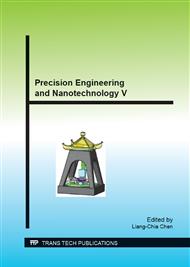[1]
Control Augmentation Using Fuzzy Logic Control, Akio KATO et al, Trans. japan Soc. Aero. Space Sci. Vol. 45, No. 148, pp.73-82. (2002).
DOI: 10.2322/tjsass.45.73
Google Scholar
[2]
Comparisons of Open-Hole Fatigue Strength Characteristics between Candidate High Temperature Polymer Matrix Composites for the Next Generation Aircraft, Kazumi HIRANO et al, APCFS & ATEM 01, JSME-MMD, Oct. 20-22, 2001 (JSME No. 01-203).
DOI: 10.1299/jsmeatemapcfs.2.01.03.0_593
Google Scholar
[3]
Ramjet Engine Test Facility and Ram/Scramjet Engine Testing, MITANI Tohru et al, Blletin of GTSJ 1997 49.
Google Scholar
[4]
Combustion oscillations in a scramjet engine combustor with transverse fuel injection, Jeong-Yeol Choi, Fuhua Ma, Vigor Yang, Proceedings of the Combustion Institute 30 (2005) 2851-2858.
DOI: 10.1016/j.proci.2004.08.250
Google Scholar
[5]
Thermodynamic Characteristic Study of a High-temperature Flow-rate Control Valve for Fuel Supply of Scramjet Engines, ZENG Wen, TONG Zhizhong, LI Songjing, LI Hongzhou, ZHANG Liang, Chinese Journal of Aeronautics25 (2012) 559-565.
DOI: 10.1016/s1000-9361(11)60419-6
Google Scholar
[6]
Recent progress in scramjet/combined cycle engines at JAXA, Kakuda space center, Tetsuo Hirakawa et al, Acta Astronautica 63 (2008) 565 – 574.
DOI: 10.1016/j.actaastro.2008.04.011
Google Scholar
[7]
Flame structures and combustion efficiency computed for a Mach 6 scramjet engine, Tohru Mitani, Toshinori Kouchi, Combustion and Flame 142 (2005) 187–196.
DOI: 10.1016/j.combustflame.2004.10.004
Google Scholar
[8]
Strengths of C/C composites under tensile, shear, and compressive loading: Role of interfacial shear strength, Hiroshi Hatta, Kenn Goto, Takuya Aoki, Composites Science and Technology65 (2005)2550-2562.
DOI: 10.1016/j.compscitech.2005.07.012
Google Scholar
[9]
Thermal Shock Behavior in SiC-coated Carbon-Carbon Composites, Yasuo Kogo et al, JSME/ASME International Conference on Materials and Proseccing 307-310.
DOI: 10.1299/jsmeintmp.10.2.307
Google Scholar
[10]
Development of Nanostructured SiC coating on Advanced Carbon Materials and Their Application, MORISADA Yoshiaki et al, Trans. JWRI, vol. 33, (2004), No. 2.
Google Scholar
[11]
Ablation behavior of SiC fiber/carbon matrix composites under simulated atomosheric reentry conditions, Toshio ogasawara, Takuya Aoki et al, composites: Part A 42 (2011) 221-228.
DOI: 10.1016/j.compositesa.2010.10.015
Google Scholar
[12]
Interdiffusion of hafnium carbide and titanium carbide during hot-pressing, C. Heiligers, Int. Journal of Refractory Metals and Hard Materials 31 (2012) 51–55.
DOI: 10.1016/j.ijrmhm.2011.09.005
Google Scholar
[13]
Helium Gas Permeability of Low Activation SiC/SiC Composite, Takahiro JINUSHI et al, Journal of the Vacuum Society of Japan Vol. 46, No. 7 (2003).
Google Scholar
[14]
Room-and Elevated-Temperature Mechanical Properties of SiC Fiber-Reinforced SiC Composite Fabricated by and PIP Methods, Katsumi YOSHIDA et al, journal of the Ceramic Society of Japan 108.
DOI: 10.2109/jcersj.108.1255_224
Google Scholar
[3]
224-229 (2000).
Google Scholar
[15]
Ablation behavior of HfC protective coatings for carbon/carbon composites in an oxyacetylene combustion flame, Ya-lei Wang, Xiang Xiong, Guo-dong Li, Huai-fei Liu, Zhao-ke Chen, Wei Sun, Xue-jia Zhao, Corrosion Science 65 (2012) 549-555.
DOI: 10.1016/j.corsci.2012.08.064
Google Scholar
[16]
Ablative property of HfC-based multilayer coating for C/C composites under oxy-acetylene torch, Wang Yong-jie, Li He-jun, Fu Qian-Gang, Wu Heng, Yao Dong-jia, Wei Bing-Bo, Applied Surface Science 257 (2011) 4760-4763.
DOI: 10.1016/j.apsusc.2010.11.020
Google Scholar
[17]
Preparation and ablation properties of Hf(Ta)C co-deposition coating for carbon/carbon composites, Ya-lei Wang et al, Corrosion Science 66 (2013) 177–182.
DOI: 10.1016/j.corsci.2012.09.016
Google Scholar


